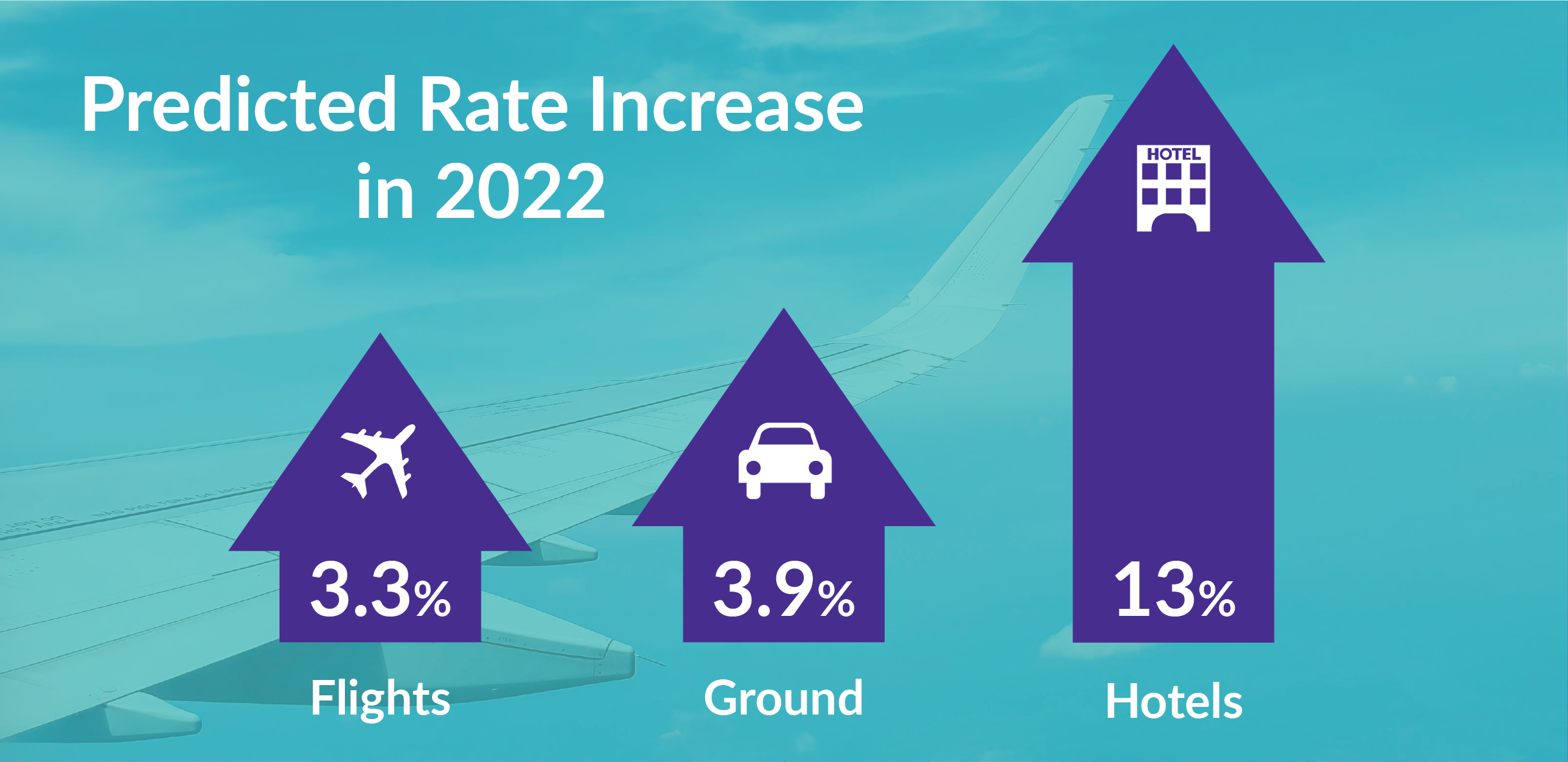Forecasting your 2022 Travel Budget
The Why Behind Rate Increases
We are all pleased to see a solid rebound in business travel experiences. Unfortunately, a recent Global Business Travel Association (GBTA) study outlines an expectation for rate increases in each travel sector for the next two years, based upon a number of reasons.
Starting with 2022, increases are forecasted as follows:

Overall increases are due to higher demand, capacity constraints, sustainability demands (both government and traveler led), plus increased labor and fuel costs. This forecast provides our corporate travel partners with background to assist your planning and budgeting for the coming year.
Flights: 3 Factors Impacting Air Rate Increases
Airfares have fluctuated greatly over the last 2 years with an increase of 2.6% in 2019, then falling 3.1% in 2020. Further impacts in 2021 were led by a 38% decline in premium class, followed by a nearly 19% decline in economy class tickets. Based on the following parameters, a 3.3% increase is expected in 2022, and a 3.4% increase in 2023.
1st factor: Pent Up Demand for Leisure Travel
Unsurprisingly, travelers around the world were eager to get back to travel, even if their corporate travel was still on pause. More leisure travelers and first time travelers were ready to get out of the house and explore locations in-country, which assisted the airlines to open new routes and expand service.
However, due to capacity constraints, business travelers will be competing for seats faster than capacity is likely to return, driving up the cost of the fares.
2nd factor: Pandemic Legislation
Every country around the world has entry requirements set as a result of pandemic levels within their country, and in other regions. As these requirements continue to shift, airlines align their routes based on country entry specifications which impact staffing, airport contracts and of course, scheduling. It is very challenging for the carriers to not only manage which airplanes will be traveling to each location, but also manage the right routes at the right time.
Through impacts of schedule management, higher oil prices increasing operational costs, and a higher ratio of domestic to international routes, airlines will be seeking to improve profitability throughout 2022.
3rd factor: Rail as an Alternative to Short-Haul Flying
Whether it is based on sustainability programs and new business travel policies, rail is rapidly replacing short-haul flying options. Although not necessarily as big a factor in the U.S. (outside of possibly Washington D.C., New York and Boston), many countries around the world, such as France, banned regional air if the route could be traveled by train within two and a half hours.
Hotels
Hotel rates pre-pandemic were on a consistent yet moderate escalation of rate increases. However, in 2020 rates fell 8.3%, and an additional 17.7% in 2021, with prices as of Q3 2021 down from 2019 levels by approximately 25%.
Projections for hotel increases globally are 13% in 2022, followed by a further 10% in 2023. This is being led primarily through the opening of international borders and increased demand. Meetings and conferences are also returning to in person events, although smaller in attendance. The Hotel industry is being further impacted by higher operating costs as sustainability measures become more standardized, along with costs and the disruption of supply chain.
Ground Transportation
Global car rental prices fell 2% in 2020 and recovered 1.2% in 2021. Forecasts outline expectations for further increases of 3.9% in 2022 and an additional 3.0% in 2023.
The restricted supply of new vehicles, combined with the boost in demand from leisure travel are driving higher prices currently, and are expected to continue for the upcoming short and medium-term. Suppliers are increasing their fleets as a matter of urgency, but due to semiconductor computer chip shortages, fleets will likely not be replenished until 2023.
The offer of electric vehicles is also going to be pivotal over the next three years, with sustainability a key priority for employers and employees alike.




Leave a Reply
Want to join the discussion?Feel free to contribute!